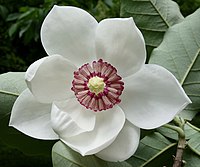
Three unprecedented biphenyl derivatives bearing C6-C3 carbon skeleton from the bark of Magnolia officinalis var. biloba
Sign Up to like & getrecommendations! Published in 2020 at "Chinese Chemical Letters"
DOI: 10.1016/j.cclet.2019.09.058
Abstract: Abstract (±)-Magoilgomer A [(±)-1] and magoilgomer B (2) were identified from the bark of Magnolia officinalis var. biloba. (+)-1 and (−)-1 were a pair of novel biphenyl derivatives featuring three C6-C3 subunits. 2 was an… read more here.
Keywords: magnolia officinalis; biphenyl derivatives; var biloba; bark magnolia ... See more keywords

Isolation and structural elucidation of bioactive obovatol dimeric neolignans from the bark of Magnolia officinalis var. biloba.
Sign Up to like & getrecommendations! Published in 2021 at "Phytochemistry"
DOI: 10.1016/j.phytochem.2021.113020
Abstract: (+)/(-)-Diobolignans A-F, six pairs of enantiomeric obovatol dimeric neolignans, were isolated from the bark of Magnolia officinalis var. biloba. (+)/(-)-Diobolignans A to C possessed a dioxane ring between the benzene ring and the propyl side… read more here.
Keywords: dimeric neolignans; obovatol dimeric; magnolia officinalis; var biloba ... See more keywords

Pharmacokinetics and metabolites of glycosides and lignans of the stem bark of Magnolia officinalis in functional dyspepsia and normal rats using LC-MS/MS.
Sign Up to like & getrecommendations! Published in 2022 at "Journal of separation science"
DOI: 10.2139/ssrn.3948395
Abstract: The stem bark of Magnolia officinalis is a traditional Chinese medicine for the treatment of abdominal distention and functional dyspepsia. The pharmacokinetics of three glycosides (magnoloside A, magnoloside B, and syringin) and two lignans (honokiol… read more here.
Keywords: dyspepsia; honokiol magnolol; magnolia officinalis; functional dyspepsia ... See more keywords